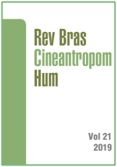Training intensity distribution of young elite soccer players
DOI:
https://doi.org/10.1590/1980-0037.2019v21e56955Resumen
The current study described the training load and intensity distribution of 30 elite Under 20 soccer players (17.9 ± 0.6 years, 180.3 ± 5.7 cm, 73.7 ± 8.8kg) from a 3-time FIFA Club World Cup champion. Session-rating of perceived exertion (s-RPE), internal training load (ITL) and monotony were recorded across 40 training sessions. Mixed-effects modeling was used for data analysis. The athletes performed 33.0 ± 6.9 out of 40 planned training sessions. Most common reasons for absence from training included sickness or minor injuries. Overall, these training sessions summed 2928.7 ± 627.6 minutes. Athletes performed significantly more training sessions at low and moderate intensity zones than at high-intensity zone (p <0.0001). The current data indicate that elite young soccer players perform their training sessions predominantly at the low-intensity zone. Training monitoring is an important aspect of the sport training process evolution. In fact, previous evidencehas already shown that an appropriate intensity distribution preventsmaladaptation from sports training and may optimize athletic performance. Therefore, coaches should implement strategies to monitor training loads during pre-season and competitive periods.
Citas
Issurin V. Block periodization versus traditional training theory: A review. J Sports Med Phys Fitness 2008;48(1):65-75.
Rowbottom DG. Periodization of training. In: Garret WE, Kirkendall DT, editors. Exercise and Sport Science. Philadelphia: Lippincott Williams and Wilkins; 2000. p. 499-514.
Turner A. The science and practice of periodization: a brief review. Strength Cond J 2011;33(1):34-46.
Moreira A, Bilsborough JC, Sullivan CJ, Ciancosi M, Aoki MS, Coutts AJ. The Training Periodization of Professional Australian Football Players During an Entire AFL Season. Int J Sports Physiol Perform 2015;10(5):566-71.
Seiler S. What is best practice for training intensity and duration distribution in endurance athletes? Int J Sports Physiol Perform 2010;5(3):276-91.
Seiler S, Kjerland GO. Quantifying training intensity distribution in elite endurance athletes: Is there evidence for an optimal distribution? Scand J Med Sci Sports 2006;16(1):49-56.
Steinacker JM, Lormes W, Lehmann M, Altenburg D. Training of rowers before world championships. Med Sci Sports Exerc 1998;30(7):1158-63.
Fiskerstrand Å, Seiler S. Training and performance characteristics among Norwegian international rowers 1970–2001. Scand J Med Sci Sports 2004;14(5):303-10.
Seiler S. What is best practice for training intensity and duration distribution in endurance athletes? Int J Sports Physiol Perform 2010;5(3):276-91.
Esteve-Lanao J, Juan AF, Earnest CP, Foster C, Lucia A. How do endurance runners actually train? Relationship with competition performance. Med Sci Sports Exerc 2005;37(3):496-504.
Algrøy EA, Hetlelid KJ, Seiler S, Pedersen JI. Quantifying training intensity distribution in a group of Norwegian professional soccer players. Int J Sports Physiol Perform 2011;6(1):70-81.
Lovell TWJ, Sirotic AC, Impellizzeri FM, Coutts AJ. Factors affecting perception of effort (session rating of perceived exertion) during rugby league training. Int J Sports Physiol Perform 2013;8(1):270-6.
Freitas CG, Aoki MS, Franciscon CA, Arruda AFS, Carling C, Moreira A. Psychophysiological responses to overloading and tapering phases in elite young soccer players. Pediatr Exerc Sci 2014;26(2):195-202.
Mortatti AL, Moreira A, Aoki MS, Crewther BT, Castagna C, de Arruda AFS, et al. Effect of competition on salivary cortisol, immunoglobulin A, and upper respiratory tract infections in elite young soccer players. J Strength Cond Res 2012;26(5):1396-401.
Foster C, Florhaug JA, Franklin J, Gottschall L, Hrovatin LA, Parker S, et al. A new approach to monitoring exercise training. J Strength Cond Res 2001;15(1):109-15.
Impellizzeri FM, Rampini E, Coutts AJ, Sassi A, Marcora SM. Use of RPE-based training load in soccer. Med Sci Sports Exerc 2004;36(6):1042-7.
Borg G. Borg's perceived exertion and pain scales. Champaign, IL: Human Kinetics Publishers; 1998.
Cooper HM, Hedges LV. The Handbook of research synthesis. New York: Russel Sage Foundation; 1994.
Castagna C, Impellizzeri FM, Chaouachi A, Bordon C, Manzi V. Effect of training intensity distribution on aerobic fitness variables in elite soccer players: A case study. J Strength Cond Res 2011;25(1):66-71.
Coffey VG, Hawley JA. The molecular bases of training adaptation. Sports Med 2007;37(9):737-63.
Issurin VB. New horizons for the methodology and physiology of training periodization. Sports Med 2010;40(3):189-206.
Coutts AJ, Reaburn P, Piva TJ, Rowsell GJ. Monitoring for overreaching in rugby league players. Eur J Appl Physiol 2007;99(3):313-24.
Brink MS, Nederhof E, Visscher C, Schmikli SL, Lemmink KAPM. Monitoring load, recovery, and performance in young elite soccer players. J Strength Cond Res 2010;24(3):597-603.
Foster C. Monitoring training in athletes with reference to overtraining syndrome. Med Sci Sports Exerc 1998;30(7):1164-8.
Suzuki S, Sato T, Maeda A, Takahashi Y. Program Design Based on A Mathematical Model Using Rating of Perceived Exertion for An Elite Japanese Sprinter: A case Study. The J Strength Cond Res 2006;20(1):36-42.
Suzuki S, Sato T, Takahashi Y. Diagnosis of training program for a Japanese rower by using the index of monotony. Can J Appl Physiol 2003;28:105-6.
Stolen T, Chamari K, Castagna C, Wisloff U. Physiology of Soccer: An update. Sports Med 2005;35(6):501-36.
Descargas
Publicado
Número
Sección
Licencia

Direitos Autorais para artigos publicados nesta revista são do autor, com direitos de primeira publicação para a revista. Em virtude da aparecerem nesta revista de acesso público, os artigos são de uso gratuito, com atribuições próprias, em aplicações educacionais e não-comerciais, desde que seja dada a atribuição. Esta obra foi licenciada com uma Licença Creative Commons Atribuição 4.0 Internacional - CC BY


